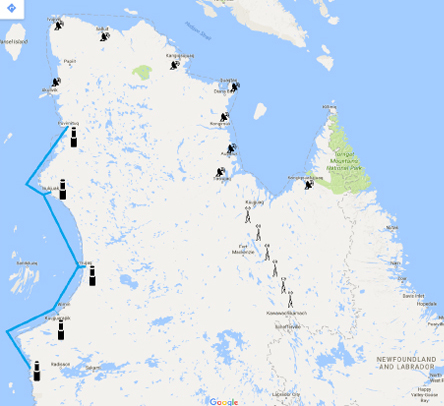Nunavik’s undersea survey set to begin this summer
The undersea survey is the first step toward fiber optic cable — and better broadband internet — for the region.
The Kativik Regional Government has awarded a contract to an American firm to do the technical work ahead of a proposed seabed survey along Nunavik’s Hudson Bay coast this summer — the first step towards laying fiber-optic cable in the region.
WFN Strategies, which specializes in submarine fiber cable systems, will assist with “technical specifications” in advance of the undersea survey along the coast during the 2018 open water season, WFN and the KRG announced earlier this month.
The KRG has yet to launch a call for tenders for the survey itself, but the completed work will be used for the construction of the proposed Eastern Arctic Undersea Fibre Optic Network, a submarine cable system, starting in 2019.
Under the plan, the KRG’s Tamaani Internet will lay undersea fiber optic cable from Chisasibi north to Kuujjuaraapik, Umiujaq, Inukjuak and Puvirnituq, to have the network in operation by 2020.

The project is still waiting on $125 million from different levels of government to fund its first phase, though the KRG expects to receive a response by March.
The KRG initially planned to lay fiber optic throughout the region by 2021.
But after completing a feasibility study in 2016, the regional government opted to use a combination of technologies to help deliver high-speed interview to Nunavik, including fiber optic to the four Hudson coast communities, microwave towers connecting Kuujjuaq to Schefferville, and then adding surplus satellite capacity to the remaining communities.
Once the fiber optic is laid, however, there will be the opportunity to extend the network later on.
Over the longer term, a second phase could extend the fiber optic from Puvirnituq to Akulivik, Ivujivik and Salluit between 2019 and 2021.
And from 2021 to 2023, a third phase expand that network from Kuujjuaq to Iqaluit and possibly Nuuk, Greenland, at an estimated cost of $100 million, though no funding sources have been identified.
The KRG and Tamaani only just completed a bandwidth upgrade in the region by shifting to a new satellite provider, which has upped internet speeds from 1.5 megabits per second to up to three and four megabits per second for its more than 3,000 customers.
But a 2017 ruling from Canada’s communications watchdog, the Canadian Radio-television and Telecommunications Commission, said that all Canadians must have access to broadband internet with at least 50 megabits per second download speeds or 10 megabits per second upload speeds.
WFN Strategies is the same firm that surveyed the cable route under the former Arctic Fiber scheme, which proposed to lay fibre from London to Toyko via the Northwest Passage.